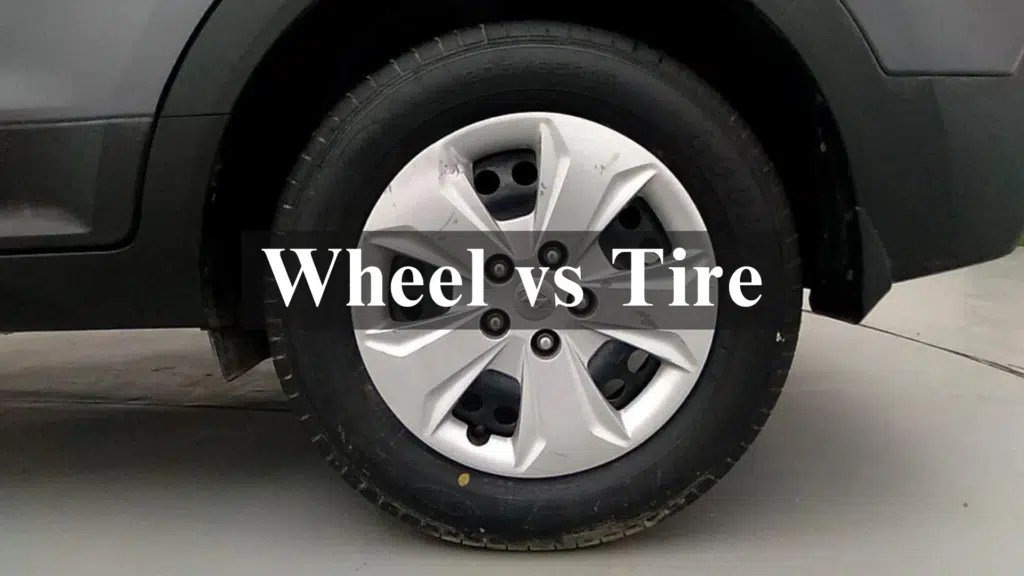When it comes to vehicle components, “wheels” and “tires” are terms often used interchangeably, but they serve different purposes.
A wheel is the metal framework that supports the tire and allows it to rotate. It includes components like the rim, spokes, and hub.
Conversely, the tire is the rubber part that comes in contact with the road, providing traction and absorbing shocks.
Despite their close relationship, it’s important to understand that the wheel and tire are separate parts. Each plays a unique role in the vehicle’s overall performance.
Misunderstanding the difference can lead to confusion when choosing replacements or maintaining your car’s wheels and tires properly.
Overview of Wheel and Tire Differences

The wheel and the tire are two distinct yet interconnected parts of a vehicle, each serving a specific purpose.
The wheel is the rigid, circular component that connects to the vehicle’s axle, allowing it to rotate and support the vehicle’s weight.
It has several components, including the rim, hub, and spokes. The rim is where the tire is mounted, the hub is the central part that connects to the vehicle’s axle, and the spokes help distribute the load evenly across the wheel.
In contrast, the tire is made of rubber and covers the wheel. It includes parts like the tread, sidewall, and bead.
The tread is the outer surface of the tire that makes contact with the road, providing traction. The sidewall helps maintain the tire’s structure, while the bead ensures a tight fit between the tire and the wheel.
The wheel and tire work harmoniously to ensure the vehicle’s performance, stability, and safety. The tire’s grip and shock-absorbing ability, combined with the wheel’s strength, allow the vehicle to move smoothly and handle different terrains effectively.
What Is a Wheel?
A wheel is a critical component of any vehicle. It allows the vehicle to move by providing a connection between the vehicle’s axle and the ground.
It supports the tire and ensures smooth rotation, which is essential for vehicle movement and handling.
Components of a Wheel
The wheel consists of several parts, each serving a vital function:
- Rim: The wheel’s outer edge that holds the tire in place. The rim ensures a tight fit between the tire and the wheel.
- Hub: The central part of the wheel that connects to the vehicle’s axle. It helps transfer the rotational force to the wheel.
- Spokes: These are the metal bars that radiate from the hub to the rim. They provide strength and stability by evenly distributing the load across the wheel.
- Barrel: The area between the rim and the hub. It provides structural support to the wheel and helps maintain its shape.
Each part works together to ensure the wheel can bear the weight of the vehicle while providing safe and efficient performance.
Types of Wheels
Wheels come in various types and materials, each suited for different needs and types of vehicles:
- Steel Wheels: These are durable and cost-effective, making them popular for everyday vehicles and trucks. They are less prone to bending but may not be as visually appealing as other types.
- Aluminum Alloy Wheels: Lighter than steel, aluminum alloy wheels offer better performance by reducing the vehicle’s overall weight. They are commonly used in sports cars and luxury vehicles for better speed and fuel efficiency.
- Chrome Wheels: Known for their shiny, reflective surface, they are often used for aesthetic purposes. They are typically found in custom or high-end vehicles and require more maintenance to keep their shine.
Different materials and types of wheels are chosen based on a vehicle’s purpose, such as everyday driving, performance, or style.
Functions of a Wheel
The primary function of a wheel is to support the tire and facilitate smooth rotation. The wheel helps distribute the vehicle’s weight evenly, providing stability during movement.
The wheel allows the tire to rotate smoothly, ensuring that the vehicle can move efficiently, handle turns, and maintain grip on the road.
In addition, the wheel absorbs some of the impacts from bumps or rough surfaces, contributing to a smoother ride.
In short, the wheel’s role is essential in maintaining the vehicle’s overall performance, safety, and comfort.
What Is a Tire?
A tire is an essential vehicle component that fits around the wheel. It plays a significant role in providing traction, absorbing shocks, and supporting the vehicle’s weight.
Tires ensure the vehicle stays in control, offers a smooth ride, and operates safely across different road conditions.
Components of a Tire
A tire is made up of three main parts:
- Tread: This is the outer layer of the tire that makes contact with the road. The tread provides traction, helping the vehicle grip the road, especially in different weather conditions.
- Sidewall: Located between the tread and the bead, the sidewall helps the tire maintain shape and provides flexibility. It also protects the inner parts of the tire.
- Bead: The bead is the part of the tire that seals it to the rim of the wheel, ensuring it stays securely in place. It helps the tire maintain a proper fit on the wheel, which is critical for safety.
Together, these components work to provide the necessary grip and shock absorption to ensure safe and comfortable driving.
Types of Tires
There are various types of tires designed for specific conditions:
- All-Season Tires: These tires are designed to perform well in most weather conditions, providing a balance between traction, handling, and durability. They are ideal for areas with mild temperatures and dry or wet conditions.
- Winter Tires: Made with special rubber compounds, winter tires offer better traction in cold temperatures and snowy or icy conditions. They are designed to maintain flexibility in low temperatures, ensuring better grip and stability.
- Performance Tires: These tires are designed for high-speed driving and superior handling on dry, smooth roads. They are often used in sports cars and other performance vehicles that require maximum control and responsiveness.
Each type of tire is designed to meet specific needs based on weather and driving conditions.
Functions of a Tire
Tires serve several critical functions for vehicle safety and performance:
- Providing Grip: Tires help a vehicle maintain traction with the road, making it easier to accelerate, brake, and turn.
- Absorbing Shocks: Tires absorb the impact of bumps, potholes, and uneven surfaces, ensuring a smooth and comfortable ride for passengers.
- Ensuring Smooth Driving: A good set of tires contributes to the overall comfort of the ride by minimizing road noise and vibration, providing a smoother driving experience.
Tires are crucial for handling, control, and comfort, making them a key component of vehicle safety.
How Wheel and Tire Work Together
The wheel and tire are two distinct components, but they must work together to ensure the vehicle functions safely and efficiently.
The wheel provides the structure and support that holds the tire in place, while the tire provides the necessary traction, grip, and shock absorption. This relationship is essential for proper vehicle performance, control, and safety.
When choosing wheels and tires, it is crucial to select compatible components. The tire must fit correctly onto the wheel, and both must suit the vehicle’s weight, handling needs, and the driving you do.
For example, a performance vehicle might require high-performance tires and lightweight, strong wheels, while off-road vehicles need durable tires and wheels that can handle rough terrain.
Using mismatched wheels and tires can lead to poor handling, increased wear, and even safety issues.
Ensuring compatibility between these two components allows the vehicle to perform at its best, providing the right balance of comfort, control, and safety across different driving conditions.
Common Misconceptions about Wheels and Tires
Using “Rim” and “Wheel” Interchangeably
Many people mistakenly use the term “rim” when referring to the “wheel.” While they may seem interchangeable, they actually represent different parts of the wheel assembly.
The “rim” refers to the outer edge of the wheel where the tire is mounted, while the “wheel” is the entire metal structure, including the hub, spokes, and rim.
The confusion arises because the rim is the most visible part of the wheel, but it’s important to remember that the full wheel is much more than just the rim.
Using the terms correctly helps to clarify the difference and improve understanding of vehicle components.
Understanding the Role of Both Components
Both the wheel and tire are essential for a vehicle’s overall performance, safety, and handling. The wheel supports the tire and ensures it remains securely in place, while the tire provides grip, absorbs shocks, and contributes to the overall comfort of the ride.
Neglecting either component can cause problems. For example, worn-out tires can lead to decreased traction and longer stopping distances, while damaged wheels can affect the vehicle’s stability and alignment.
Ensuring both components are in good condition is crucial for safe driving and optimal vehicle performance.
Regular maintenance and timely tire and wheel replacements are key to ensuring your vehicle performs at its best.
How to Choose the Right Wheel and Tire Combination
Several factors come into play when selecting the right wheel and tire combination. The type of vehicle you drive, your driving habits, and the conditions in which you typically drive all influence your choice.
For trucks, you may want durable wheels and tires that can handle heavy loads and provide traction in tough conditions like mud or snow.
For performance cars, you’ll need a combination of low-profile tires and high-performance wheels that focus on grip, stability, and speed.
Off-road vehicles benefit from wheels and tires that are designed to withstand rough terrain and offer more ground clearance.
Balancing the look and functionality is essential. While larger wheels may look appealing, they can affect your vehicle’s performance if not paired with the right tires. Be sure to consider the vehicle’s overall performance and desired appearance.
The tire’s width, profile, and tread pattern must complement the wheel size, ensuring a safe and effective driving experience. Regularly consulting a professional can help ensure that the combination suits your specific needs.
Maintenance of Wheels and Tires
Maintaining Wheels
Regular cleaning is important to keep your wheels in good condition. Start by washing them with a mild soap to remove dirt, grime, and brake dust.
This prevents the buildup of harmful substances that can cause corrosion. Use a soft cloth or brush to clean the surface and avoid scratching the finish.
For added protection, apply a layer of wax to shield the wheels from moisture and road salts. If your wheels are made from materials like aluminum or chrome, inspect them for signs of wear, such as pitting or cracks.
Ensure the bolts are properly tightened and check for any bends or damages. If you notice any, it’s best to have a professional repair them to avoid further damage.
Maintaining Tires
Proper tire maintenance ensures safety and longevity. Start by regularly checking the tire pressure to ensure it matches the vehicle’s recommended levels.
Under-inflated tires can cause poor fuel economy, while over-inflated tires may increase the risk of a blowout.
It’s also important to check the tread depth; when the tread wears down, tires lose their ability to grip the road, especially in wet or slippery conditions.
Rotate your tires every 6,000 to 8,000 miles to ensure even wear. Inspect your tires for punctures, cracks, or bulges that indicate internal damage. Proper tire care can extend the life of your tires and improve your vehicle’s overall performance.
Conclusion
Understanding the difference between wheels and tires is essential for maintaining vehicle performance. While the wheel supports the tire and allows it to rotate, the tire provides traction and absorbs shocks. Both components work together to ensure smooth and safe driving.
Regular maintenance is crucial for both wheels and tires. Keeping wheels clean and free of damage ensures longevity, while proper tire care, like checking air pressure and tread depth, keeps your vehicle safe on the road.
By understanding these components and their functions, you can make informed decisions about your vehicle’s needs, improve its performance, and enhance safety. Proper care ensures your vehicle stays in top shape for years to come.
Frequently Asked Questions
What Is the Difference Between a Wheel and a Tire?
A wheel is the metal part of a vehicle that holds the tire in place, while the tire is the rubber part that provides traction and absorbs shocks.
Can I Use Any Tire with Any Wheel?
No, it’s important to choose a tire that fits the wheel’s size and load rating. Compatibility between the tire and wheel ensures safety and proper vehicle performance.
How Often Should I Replace My Tires?
Tires should be replaced when the tread depth reaches 2/32 inches or less or if they show signs of damage, such as cracks, bulges, or punctures.
Can I Drive with Damaged Wheels?
Driving on damaged wheels is unsafe as it can lead to tire failure or affect vehicle handling. It’s best to replace damaged wheels promptly.
How Do I Maintain the Health of My Tires?
Check tire pressure regularly, rotate your tires every 6,000 to 8,000 miles, and inspect tread depth for wear. Proper maintenance extends tire life.
What Type of Wheels Are Best for Off-Road Vehicles?
For off-road vehicles, stronger wheels such as aluminum alloy or steel are preferred, as they are durable enough to withstand rough terrains and heavy loads.


